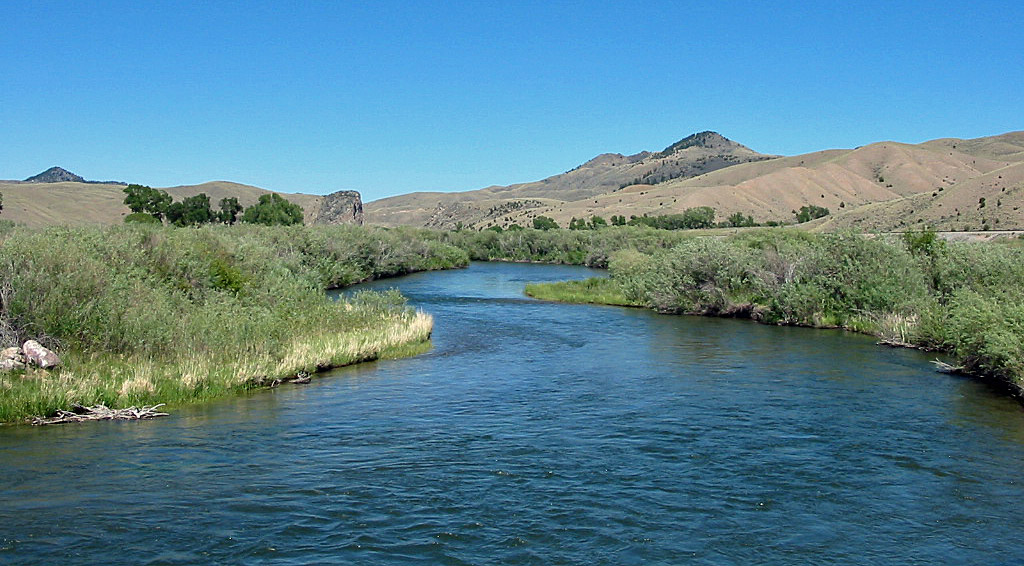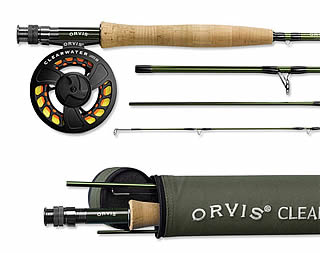The Beaverhead River is one of the premier brown trout fishing rivers in Montana. The Beaverhead produces more large trout brown trout on a consistent basis than any other river in Montana.
Table of Contents:
- Beaverhead River – Introduction & Overview
- Fishing the Beaverhead River – Overview
- Fishing the Beaverhead River Between Clark Canyon Dam and Barrett’s Dam
- Fishing the Beaverhead River Between Barrett’s Dam and Dillon
- Fishing the Beaverhead River Downstream from Dillon
- Floating the Beaverhead River
Related Article – Beaverhead River Photographs
Beaverhead River | Introduction & Overview
The Beaverhead River begins at Clark Canyon Dam, near Dillon, and flows for 80 miles to the confluence with the Jefferson River.
For the first sixteen miles, downstream to Barrett’s Dam, the river flows through arid hillsides. Traversing this section of river, the Beaverhead is rarely in a straight line for long, as it constantly twists and turns in its route through the hills. The banks of the Beaverhead River are lined with willows, cottonwood trees and grass.
Due to the excellent fly fishing, this section receives very heavy use from float parties. Access to this section of the Beaverhead River is good, as many official access sites exist and the river flows partially through public lands.
Below Barrett’s Dam, the Beaverhead River flows into the valley. Irrigation takes a heavy toll on the Beaverhead from Barrett’s Siding downstream to Dillon. In late summer during low water years, this section of river may prove unfloatable due to very low river levels. The fluctuating river levels also severely hamper the fishing. Except for at the designated sites, access is difficult since the river flows primarily through private land.
Below Dillon, irrigation use is somewhat less, but the river flows very slowly through predominantly private land.
Fishing the Beaverhead River – Overview & Introduction
The Beaverhead River, particularly the upper stretch between Clark Canyon Reservoir and Barrett’s Diversion Dam, is perhaps the most difficult river to fish in Montana. Heavy use, large and fussy brown trout, small nymphs, delicate tippets, frequent difficult water conditions and the twisty nature of the river all conspire to make fly fishing the Beaverhead River a difficult experience.
But the difficulty is not without rewards. The Beaverhead River is prime water for for large brown trout—real large brown trout. A common brown trout, particularly on the upper section, ranges from twelve to fifteen inches. Larger browns, stretching well past the twenty-inch mark, are also present in high numbers. For the angler looking to chase trophy-sized brown trout, the Beaverhead River is the place to visit.
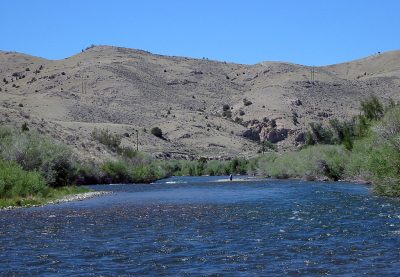
The Beaverhead River flows primarily through arid terrain.
Before venturing to the Beaverhead River, a word should be said about its flows and how they are regulated, as the flows greatly affect fishing. Clark Canyon Reservoir regulates the flow of the Beaverhead River. During the late winter period and in spring, the reservoir fills up, slowing the current in the river down substantially (water is withheld from the river to fill the reservoir).
During the summer, the reservoir releases significant flows of cold water that are siphoned off for irrigation at Barrett’s Diversion Dam. This diversion dam frequently takes half or more of the water in the river, thus leaving the stretch below the diversion dam with low water throughout much of the summer.
Prime float fishing flows between Clark Canyon Reservoir and Barrett’s Diversion Dam is considered to be 600-1000 cfs. At this flow rate, wade fly fishing is difficult. Wade fishing is not particularly easy on the upper stretch to begin with, and with high flows, wade anglers are frequently not able to fight the fast and deep current to cross the river to reach prime fishing holes.
Better wade angler flows occur when the river drops to 300 cfs. When the river flows over 1500 cfs, fishing becomes next to impossible for wade anglers and exceptionally difficult for float anglers. At these high flow rates, the Beaverhead River can become muddy and very turbid, limiting fishing success. Additionally, the high flows only add to a normally fast current that whisk the float angler downstream that much faster, making presentation difficult.
Typical flows on the Beaverhead River in winter range between 100-300 cfs, but can fall to as low as 50 cfs or less, leading to winter kill. In May and early June, flows average around 1000 cfs, but can balloon to over 1500 cfs in high water years. The river then begins to creep down, settling into August with flows around 600-800 cfs, although it can be substantially lower during drought conditions. Since the water is released from Clark Canyon Reservoir, the summer flows are still cool.
Fishing the Beaverhead River : Clark Canyon Dam to Barretts Dam
On this section of the Beaverhead River, angler use is frequently very heavy. During prime hatches and water conditions, the river often more resembles a floating highway than a fly fishing river. Pressure has gotten so heavy that that Montana FWP instituted regulations limiting float parties. These restrictions effect both guided float parties as well as out-state floaters. Before floating the Beaverhead River on this section, make sure to check out the latest fishing regulations, as they can and do change frequently.
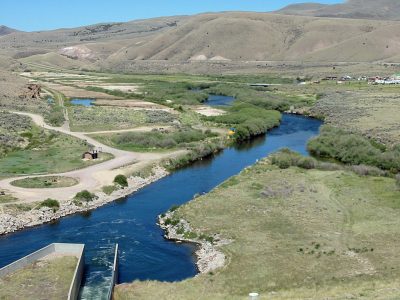
Photos of the Beaverhead River, taken from the top of Clark Canyon Dam
This stretch of Beaverhead River is where the largest fish are found and in the greatest numbers. The problem lies in catching them. The brown trout that inhabit this stretch of the Beaverhead River require precision presentations with small flies on weak leaders, all of which combine to make netting one of the larger browns a tough proposition.
The upper stretch of river is primarily a nymph fishing river. While large fish are taken on dry flies, and the Beaverhead River does have excellent caddis hatches during the summer, the bulk of all large fish caught on the Beaverhead River are caught using nymphs and streamers.
Fly fishing nymphs on the upper stretch of the Beaverhead River requires precise casts and the ability to float the nymphs in a dead drift along the banks. This is easier said than done. The current moves fast, and constant line mending is required in order to even get a short drag free drift. When fishing from a boat, expect to lose many flies to the vegetation along the bank. The light tippets required also cause many fish to be lost. Popular nymph patterns include Hares Ear, Little Beaverhead Stone and Bead Head Pheasant Tail, in sizes 10-16.
For anglers who prefer to fly fish on top, early mornings and late evenings are the best time to use dry flies. The Beaverhead River has solid hatches throughout the year. Weather plays an important role when dry fly-fishing on the Beaverhead.
On bright sunny days, little action happens on top since the fish generally stay down deep and under cover on bright days. However, on cloudy, cool days, which happen periodically during the summer, the brown trout rise to the surface to feed during hatches. Popular dry flies during the hatches include the popular staple Elk Hair Caddis, Sparkle Dun and the X-Caddis, sized 16-18.
During late summer, hopper fishing also becomes decent. While the Beaverhead River is not in the same league for hoppers as the Ruby River is, the Beaverhead still offers good action for hoppers. For the angler who prefers to fly fish on top, hoppers are an excellent summer choice.
Perhaps the best dry fly fishing on the upper stretch of the river is found in the various backwaters of the river. Brown trout are located in these backwaters, effortlessly feeding on various insects. Since the current of the river is slack in the backwaters, and frequently reversed, long drag-free floats are possible, which provide a welcome relief compared to the rest of the river in this section.
Access to the river between Clark Canyon Dam and Barrett’s Dam is excellent. Numerous fishing access sites are available, and public lands often border the river.
Fishing the Beaverhead River : Barrett’s Diversion Dam to Dillon
This section of the Beaverhead River, which covers fourteen miles, also has excellent fly fishing. Overall fish populations are not as high as they are above Barrett’s Diversion Dam. However, this section has equally large brown trout. Moreover, fishing pressure is much less than found further upstream. The result is that the brown trout are less finicky and difficult to catch.
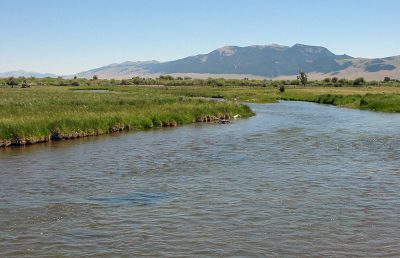
The Lower Beaverhead River downstream from Dillon
Unfortunately, access is difficult along this stretch. The Beaverhead River primarily flows through private land as it spills from the canyon and into the broad valley around Dillon. Access spots are widely spaced apart. Additionally, due to irrigation withdrawals at Barrett’s Diversion Dam, low water is often a problem for floaters along this stretch, especially in mid-summer.
Despite these problems, this stretch of the Beaverhead River offers excellent fly fishing possibilities. Since the river is much shallower and has slower current, wade fishing along this stretch is excellent. While low water levels can create problems for floaters in larger, deeper draft boats, the slower current allows anglers more time to select fishing spots and to avoid the requirement to constantly mend line.
Except during the winter months, anglers won’t find solitude along this portion of the Beaverhead River. However, they also won’t encounter the jams of rafts and other boats found further upstream.
And for the wade angler willing to walk up or downstream away from the handful of access sites, they are likely to find areas of water that are not heavily fished. Rattlesnakes are commonly found along this stretch of the river, so watch where you step.
Fishing technique on this stretch differs little from the stretch above. Nymph fishing is still the key to taking larger trout, fishing them right along the banks and into the deeper holes.
However, the dry fly angler finds a friendlier river than further upstream. Excellent caddis hatches occur along this section the entire year in the evenings once the weather starts to cool. The Elk Hair Caddis works well during these hatches. An additional option for the dry fly angler is to fish attractor patterns, floating them right along the bank, especially where obstruction such as logjams and rocks are found.
Fishing the Beaverhead River : Dillon to Confluence with Jefferson River
From Dillon downstream, fish populations thin out substantially. Large fish are found in this section, but their numbers are significantly less than found further upstream.
During the summer, this stretch of the Beaverhead River usually gets quite warm, as it runs slowly in the middle of a very arid valley. Because of the warm water and slow current, fly fishing this stretch during the summer often yields few results. Most anglers hit this stretch of the Beaverhead River during the fall once the weather and water start to cool.
That said, cooler summer weather often brings solid fishing for brown trout for short periods of time—particularly if river flows are still decent. So don’t rule this stretch out entirely if you visit the Beaverhead River during the summer. While fish populations are less per mile, the trout are just as large as found further upstream. Additionally, the trout receive substantially less fly fishing pressure than found further upstream.
Moreover, for those anglers seeking more of a secluded float than a spectacular fishing trip on the Beaverhead, then this stretch is for you. Few anglers fish this stretch, and fewer yet float it. Access to the river is also sparse on this stretch.
Throughout this stretch, the river flows are very slow and windy conditions are frequent. For this reason, low draft boats such as canoes, inflatable canoes, inflatable kayaks or pontoon boats are the best boats to use. With smaller boats, anglers can paddle easily paddle their way through the many slow water stretches.
Floating & Paddling the Beaverhead River
A float or raft trip down the Beaverhead River is not considered a prime Montana float trip. The countryside is very arid. The river frequently flows right next to a busy Interstate highway. And below Barrett’s Dam, the current often slows to a crawl and countless obstacles in the river exist, such as fences and diversion dams. The frequent low water due to irrigation also makes floating difficult.
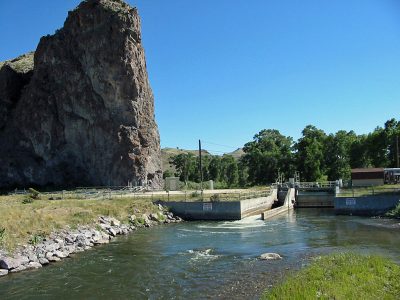
Barrett’s Dam on the Beaverhead River. Floaters will need to portage around this dam.
Still, while the Beaverhead River may not offer what other Montana rivers do in terms of float quality, floating the Beaverhead is still the best way to fish it. The deep pools and somewhat limited shore access allows float anglers to reach areas shore anglers cannot.
Below Clark Canyon Dam and running to the Barrett’s Dam, the Beaverhead twists and turns as it runs through arid hills. Don’t expect solitude on this stretch. Numerous float parties use this section of the river for fly fishing. At times, the river resembles a water bound highway. But of course, the reason all these parties are here is because the fly fishing in this section of the Beaverhead River is excellent.
At Barrett’s Dam, a portage is required. Below Barrett’s Dam is where floating pressure drops off substantially. The water often runs very slow and shallow due to irrigation withdrawal.
From Barrett’s Dam downstream to the rivers end in Twin Bridges, a floater can expect to encounter numerous diversion dams, pipes in the rivers, jetties, fences that span the entire river and many irrigation channels—with most of these obstacles encountered around Dillon.
Due to the flat water and potential requirement to portage around various obstacles, lightweight boats that draw little water are the boats of choice for floating the Beaverhead downstream from Dillon. Inflatable kayaks in particular are excellent boats for the Lower Beaverhead.
In sum, the Beaverhead River is divided into two distinct sections. The upper sixteen miles of the Beaverhead River provides nice floating with excellent fly fishing. The remainder provides a slow float around many obstacles with variable fishing.
Selected River Miles on the Beaverhead River
Listed below are selected river miles for the Beaverhead River. Visit the Montana FWP website for more information about specific sites.
- Clark Canyon Dam: 82
- High Bridge FAS: 73.2
- Hennebury FAS: 69.8
- Pipe Organ Bridge: 67.5
- Grasshopper Creek Access Site: 66
- Corrals FAS: 64
- Barrett’s Dam: 63.5
- Poindexter Slough FAS: 53.4
- Interstate 15 Bridge (Dillon): 50
- Beaverhead Rock State Park: 25.2
- Twin Bridges: 2.5
- Confluence with the Jefferson River: 0
Related Articles on Big Sky Fishing.Com
- Photographs of the Beaverhead River
- Dillon, Montana – Town info and photos
- Clark Canyon Dam – Fishing info
- Fishing the Jefferson River
- Fishing the Red Rock River
- Fishing the Ruby River


